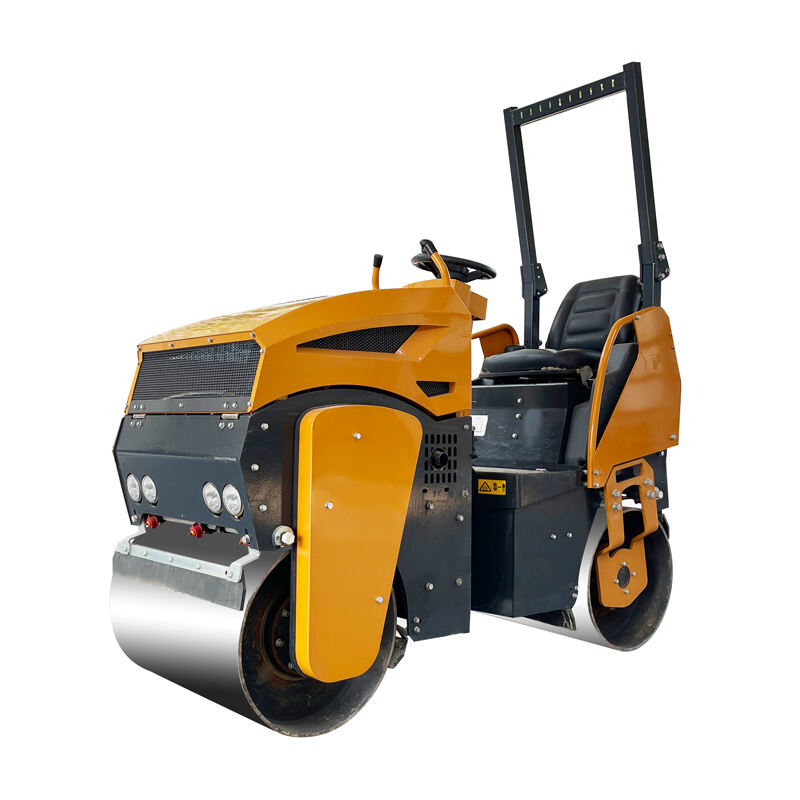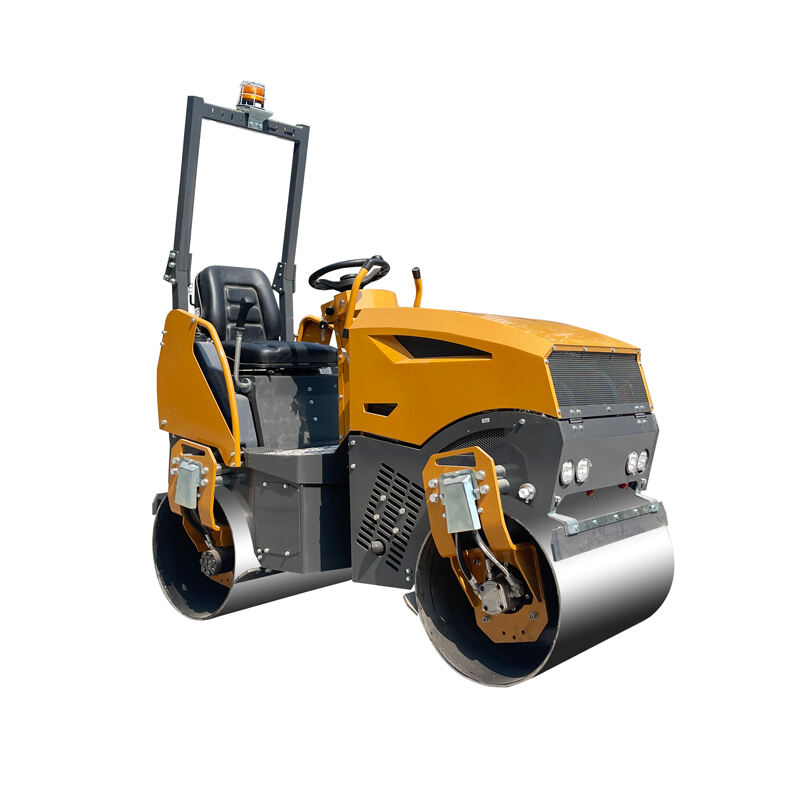Evolucija cisterni u savremenoj građevinarstvu
Rana mehanizacija: parni i životinjski pogoni valjeva
Valjci za asfalt su počeli evoluirati u vreme kada su za zbijanje površina tokom 1800-ih godina korišćene parne mašine i životinje. Ovi rani modeli predstavljali su značajan napredak u odnosu na ručni rad, jer su mogli da zbijaju materijale brže i ravnomernije po putevima i stazama. Iako su verzije na parni pogon bile prilično teške i nezgrapne za upravljanje, one su sigurno imale više snage za obavljanje posla nego bilo koja grupa radnika. Jedan značajan primer je model Aveling & Porter iz daleke 1867. godine, koji je zapravo postavio temelje za savremenu zbijnu tehniku. Kompanije poput Thomas Aveling & Co. su značajno doprinijele razvoju ove oblasti, stvarajući mašine koje su na neki način uspele da pomešaju moćne parne motore sa jednostavnim dizajnom koji je izdržao bezbroj gradjevinskih projekata.
Revolutija unutrašnjeg sagorevanja (1900-1970)
Kada su valjci za asfalt prešli sa parnog pogona na motore s unutrašnjim sagorijevanjem u 20. vijeku, to je zaista promijenilo sve u dizajnu mašinerije za izgradnju. Taj prelazak je značajno poboljšao učinak na gradilištima i omogućio mašinama da obavljaju teže zadatke nego ikada prije, praktično preuređujući ono što su ljudi očekivali od opreme za izgradnju puteva. Oko 1970. većina izvođača radova je potpuno odbacila stare parne modele u korist novijih valjaka sa unutrašnjim sagorijevanjem. Proizvodnja je naglo porasla jer su ove mašine izuzetno dobro funkcionisale svakodnevno uz minimalnu potrebu za održavanje. Kompanije poput Caterpillara su u to vrijeme počele ozbiljno uticati na tržište. Njihove mašine izdržavale su ekstremne uvjete rada, dok su konkurentske kompanije poput BOMAG-a dolazile sa sličnom pouzdanošću, ali nešto drugačijim pristupima vibracionoj tehnologiji koja je definisala narednu generaciju mašina za zbijanje.
Vibracijski sistemi i hidraulička preciznost
Kada su vibracioni sistemi prvi put ušli u uporabu, stvarno su promijenili način na koji razmišljamo o poslovima zbijanja. Ovi valjci koriste težine koje se kreću naprijed-nazad kako bi materijale zbijali čvršće, što ih čini znatno učinkovitijima kod postavljanja asfalta i izgradnje cesta. Kada se kombiniraju s hidrauličkim sistemima, operateri mogu prilagoditi koliko stroj pritiska, pa se stoga može koristiti na različitim vrstama površina i materijala. Neki stvarni terenski testovi s nedavnih cestovnih projekata pokazuju da ovi kombinirani sistemi mogu povećati brzinu zbijanja za otprilike 30 posto. Takva poboljšanja znače da su savremeni cestovni valjci postali gotovo nezaobilazni za sve koji obavljaju ozbiljne inženjerske poslove na izgradnji cesta u današnje vrijeme.
Inteligentna štampa i GPS-vedeni sistemi
Tehnologija za praćenje pametne zbijenosti potpuno je promijenila način na koji provjeravamo kvalitet tokom izgradnje puteva. Ovaj sistem prikuplja podatke u realnom vremenu tokom izvođenja radova, omogućavajući radnicima da saznaju gdje tlo nije dovoljno zbijeno kako bi odmah popravili te tačke. Većina izvođača danas koristi valjke vođene GPS-om kako bi postigli bolje rezultate zbijanja. To znači manje otpadnih materijala i kraće vrijeme izvršenja radova. Uzmimo za primjer XYZ Construction, koji je nedavno počeo koristiti sisteme koji usklađuju kretanje valjaka direktno sa nacrtima, osiguravajući da svaki centimetar bude pravilno obrađen, što je posebno važno kod velikih projekata autoputeva. Gledajući unaprijed, nema sumnje da će ova alata i dalje postajati sve efikasnija u smanjivanju troškova i ubrzavanju procesa. Očekujemo da će se u budućnosti pojaviti još pametniji sistemi koji će učiti iz prethodnih radova i automatski se prilagođavati u skladu sa uslovima na lokaciji, iako glatki prelazak svih odjela na njihovo korištenje ostaje izazov za mnoge kompanije koje i dalje koriste tradicionalne metode.
Električni/hibridni motorni za ekološke projekte
Sve više gradilišta danas prelazi na električne i hibridne valjke za asfalt jer su prakse gradnje na zeleno postale toliko važne. Razlika koju ove mašine čine je prilično upečatljiva, zapravo smanjuju emisije i troše znatno manje gorivo u poređenju sa starijim dizelskim modelima. Neka istraživanja pokazuju da električne verzije mogu smanjiti emisiju ugljenika za otprilike pola, što objašnjava zašto ih mnogi projekti fokusirani na održivost sada propisuju. Uzmite kao primjer novi projekt proširenja centra grada. Kada su koristili električne valjke tamo, pored smanjenja zagađenja, uštedjeli su i na troškovima eksploatacije. Gradnja na zeleno više nije dobra samo za planetu. Kompanije uviđaju da čista tehnologija pomaže u dostizanju onih zahtjevnih ciljeva održivosti, ali i ispunjava uslove regulatora, pogotovo kada se radi u blizini zaštićenih prirodnih zona ili historijskih mjesta gdje je dobijanje dozvola komplikovano.
Dalekovod za usiže prostore i sigurnost
Korištenje tehnologije daljinskog upravljanja kod valjaka za asfalt donosi ozbiljne pogodnosti, posebno kada se radi na tijesnim gradilištima gdje je kretanje velikim mašinama praktično nemoguće. Zahvaljujući ovim sistemima, operateri mogu upravljati opremom na daljinu, što uvelike povećava sigurnost i smanjuje rizik od nesreća. Radnici više ne stoje neposredno pored masivnih valjaka, čime se svakodnevno smanjuje opasnost na radu. Prema izvještajima iz industrije, na gradilištima koja koriste ovu vrstu daljinskog upravljanja, stopa nesreća se smanjila za oko 30%. Još jedna prednost je ta što mašine puno bolje rade u tijesnim prostorima u poređenju sa tradicionalnim metodama. One se kreću kroz uske prolaze i zavoje s puno većom preciznošću. A s obzirom da su izgradnja objekata sve češće ograničena u manjim prostorima, uz istovremeno održavanje visokih standarda sigurnosti, daljinsko upravljanje neće samo ostati, već će se vjerovatno pretvoriti u standardnu praksu širom grane.
Hot Sale Udaljeno Upravljanje 1.8Ton Cestni Val
Šta izdvaja Hot Sale daljinski upravljački 1,8 tona cestovnog valjka? Pogledajte njegove impresivne karakteristike koje su posebno dizajnirane za projekte izgradnje puteva. U srcu uređaja nalazi se moćan motor YANMAR u kombinaciji sa pouzdanim hidrauličkim motorom proizvedenim u Japanu, tvrtke Shimadzu, koji proizvodi snagu od oko 17,8 kW. Takođe, konstrukcija mašine je ergonomski dizajnirana, sa elegantnim profilon koji omogućava operateru odličan pregled sa svih strana dok radi na gradilištu. Ovdje sigurnost i produktivnost idu zajedno. Ono što zaista privlači pažnju je bežični sistem daljinskog upravljanja. Operateri mogu daljinski pokrenuti i zaustaviti motor, pomicati valjak naprijed/nazad i čak prilagoditi vibracije na daljinu. Ovo je posebno korisno kada se valjak koristi u ograničenim prostorima gdje bi tradicionalne kontrole bile nepraktične. Ove mašine smo vidjeli kako odlično rade u različitim zemljama, uključujući Tajland, Njemačku i dijelove Rusije, gdje su ograničeni prostori česti problemi.
ST1000 | 1 Ton Vibratory Roller
ST1000 1 Ton Vibracioni Valjak odlično funkcioniše na manjim radovima na putevima gdje prostor zaista važi. Dolazi sa snažnim motorom kompanije Caterpillar, kojima se mnogi izvođači rada pouzdaju. Ono što ovu malu mašinu izdvaja je njen sistem sa dva bubnja koji stvarno dobro zgušnjava materijal bez ostavljanja praznina. Takođe, kontrolna ploča nije tu samo radi izgleda – omogućava operaterima da započnu rad jednim dodirnim pritiskom, što štedi vrijeme kada se radi po strogim rokovima. I ne zaboravite noćne smjene – svjetla na oba kraja znače da radnici mogu nastaviti posao dugo nakon što sunce zađe. Ljudi koji su koristili ovaj valjak pominju koliko je lagan u vođenju kroz zavoje i krivine, a kvalitet izrade znači da će izdržati i najteže uslove. Nije čudo što ga toliko mnogo ljudi bira kada im je potrebno precizno zbijanje koje se uradi kako treba.
ST1200 | 1.2 Tona Artikulirani Kompresor
ST1200 1,2 tona Artikulirani k ompaktor zaista ističe zahvaljujući pametnom dizajnu koji dobro funkcionira na različitim površinama poput asfaltiranih cesta i šljunkovitih staza. Pokreće ga pouzdan motor marke Caterpillar, zahvaljujući čemu ovaj stroj traje duže od većine konkurencije, a pritom osigurava stabilnu učinkovitost iz dana u dan. Operateri cijene udobne kontrole i lako dostupne tipke na kontrolnoj ploči, što ga čini jednostavnim za upravljanje čak i u teškim uvjetima. Noćni rad olakšan je zahvaljujući boljim opcijama osvjetljenja ugrađenim direktno u jedinicu. Izvođači smatraju da ovaj kompaktni, ali snažan stroj može obaviti sve, od popravke rupa na cesti do zbijanja šljunkovitih baza za nove prilaze. Mnogi stručnjaci ga preporučuju jer štedi vrijeme i novac na poslovima gdje bi tradicionalni k ompaktori imali poteškoća ili bi trebali više prolaza.
ST1300 | 1.3 Tona CE-certifikovani roller
ST1300 1,3 t valjak ima CE certifikaciju što znači da ispunjava sve zahtjeve kada je u pitanju stroga industrijska sigurnost. Voditelji projekata znaju da mogu vjerovati ovom stroju jer prolazi kroz strog testiranja. Ono što zaista ističe kod ovog modela je snažni KUBOTA motor ispod haube, kao i promišljeni dizajn koji čini rad na dužim radnim danima manje zamoran. Operatori imaju i bolji pregled, pa mogu tačno vidjeti gdje rade. Izvođači smatraju da ova oprema dobro funkcioniše na različitim poslovima – od velikih projekata autoputova sve do popravki rupa na cestama. Kvalitet izrade izdržava vremenom čak i u teškim uslovima, što ga čini dobrom investicijom za svakog ko traži pouzdane rezultate zbijanja bez stalnih kvarova ili problema s održavanjem.
Budućnost kompakcije: Trendovi na koje treba da pratite
AI-podržani samoopstojni rolleri
Valjci za asfalt brzo se mijenjaju zahvaljujući umjetnoj inteligenciji, što označava početak ere mašina za izgradnju koje rade bez vozača, kako mnogi vide. Ove pametne mašine nude i stvarne prednosti. Rade brže i štede na troškovima radne snage jer je potrebno manje radnika na terenu. Osim toga, one zbijaju ceste znatno preciznije nego što dozvoljavaju tradicionalne metode. Stručnjaci u industriji smatraju da ćemo već za nekoliko godina vidjeti da umjetna inteligencija preuzima većinu mašina u izgradnji. Tada će upravljanje projektima izgledati potpuno drugačije. Prema istraživanju iz Construction Technology Review-a, neki objekti koji su koristili automatizovane valjke ostvarili su uštedu od oko 30% na troškovima rada. Istovremeno, ti objekti su završili poslove brže jer su mašine radile izuzetno dosljedno, bez pauza ili grešaka.
3D-natisane dijelove i lagane materijale
Dodavanje komponenti napravljenih dodatnom proizvodnjom u proizvodnju valjaka za asfalt mijenja način na koji proizvođači pristupaju svom poslu, omogućavajući izradu znatno kompleksnijih i učinkovitijih dizajna nego prije. Takođe, uočavamo da lagani materijali postaju važni u ovoj industriji, izravno utičući na količinu goriva koje ove mašine troše i na njihovu pokretljivost po gradilištima. Uzmimo, na primjer, aluminijumske legure i kompozitne materijale – oni su zaista otvorili nove mogućnosti za dizajnere motora, što je dovelo do valjaka koji imaju manju težinu, a i dalje imaju ozbiljnu snagu. Nekoliko građevinskih firmi, uključujući XYZ Constructions, već je počelo koristiti ove inovacije u svojim operacijama. Njihovi izvještaji pokazuju otprilike 20 posto bolju uštedu u potrošnji goriva u poređenju sa starijim modelima, kao i značajno manje otpada tokom proizvodnje, prema nedavno objavljenim nalazima u Časopisu za naprednu proizvodnju.
Pametno upravljanje flotom putem IoT mreža
IoT tehnologija postala je prilično neophodna za upravljanje modernim voznim parkovima, posebno kada je u pitanju povezivanje valjaka za asfalt i drugih mašina na prostranim mrežama koje omogućavaju praćenje u stvarnom vremenu i analizu podataka. Ove povezane sisteme olakšavaju život timovima za operacije i održavanje jer smanjuju ručno praćenje i omogućavaju predviđanje problema prije nego što se one dogode. Uzmite za primjer ABC Engineering, koji je prošle godine uveo IoT rješenja i zabilježio značajan napredak u upravljanju svojim voznim parkom. Njihovi mehaničari sada troše manje vremena na pronalaženje problema sa opremom, što rezultira nižim troškovima popravki i dužim vijekom trajanja mašina između servisa. Nedavna studija iz Časopisa za upravljanje građevinarstvom takođe ukazuje na zanimljivu činjenicu: kompanije koje integrišu IoT u svoje procese obično postižu povećanje efikasnosti svakodnevnog rada za oko četvrtinu. Takav skok u performansama znači da se više poslova obavi bez prekomjernog trošenja dodatnih resursa.
 EN
EN
 AR
AR CS
CS DA
DA NL
NL FI
FI FR
FR DE
DE IT
IT NO
NO KO
KO PL
PL PT
PT RO
RO RU
RU ES
ES SV
SV TL
TL ID
ID LV
LV SR
SR SK
SK SL
SL VI
VI SQ
SQ ET
ET TH
TH TR
TR AF
AF MS
MS GA
GA HY
HY KA
KA BS
BS LA
LA MN
MN MY
MY KK
KK UZ
UZ KY
KY











